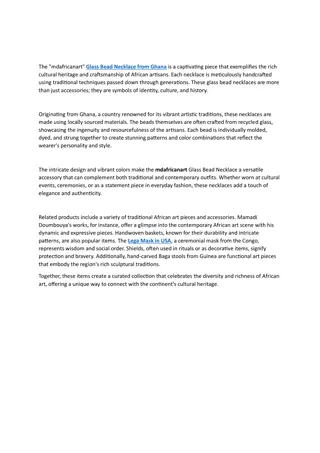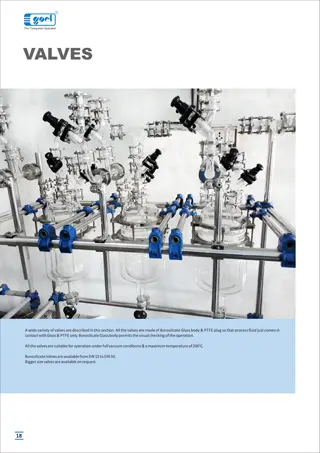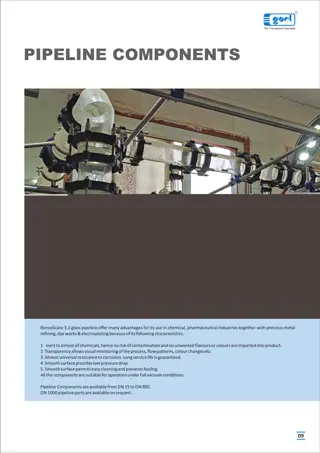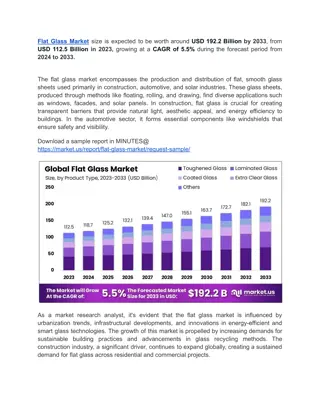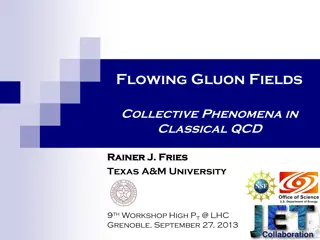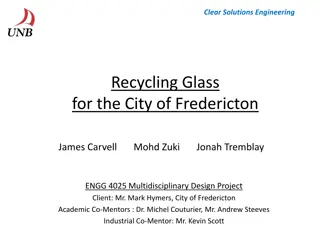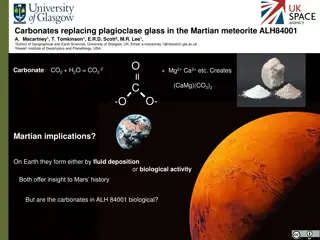Understanding the Structure of Glass for Beginners
Explore the structure of glass, including the role of glass formers, intermediates, and modifiers in creating the unique properties of different types of glass. Learn about the essential oxide components, such as SiO2 and B2O3, and how they contribute to the formation of glass networks. Discover the importance of intermediate oxides like Al2O3 in linking up with the basic glass network to enhance structural continuity and achieve special glass properties.
Download Presentation

Please find below an Image/Link to download the presentation.
The content on the website is provided AS IS for your information and personal use only. It may not be sold, licensed, or shared on other websites without obtaining consent from the author. Download presentation by click this link. If you encounter any issues during the download, it is possible that the publisher has removed the file from their server.
E N D
Presentation Transcript
GLASS LECTURE 2 Structure of Glass By Asst. Lect. Shireen Hasan
3-Structure of glass Structure is knowledge of atom positions Glass forming oxides: most inorganic glasses are based on the glass forming oxide. Silica is most widely used as glass forming constituent. The fundamental subunit in silica based glasses is SiO4 tetrahedron in which a silica si4 atom ion in the tetrahedron is covalently ironically >.bonded to four oxygen atoms ions as shown in fig. below. - In crystalline silica cristobalite the si-o tetrahedra are joined corner to corner in a regular arrangement, producing long range order as idealized in fig ( 2.b) . - In a simple silica glass the tetrahedra are joined corner to corner to from a loose network with no long range order fig (2.c ) .
The oxide components added in to a glass batch may be sub-divided as: A. Glass formers. B. Intermediated. C. Modifiers. Table 1 Division of the oxides into glass former, intermediates, and modifiers Glass formers Intermediates B2O3 SiO2 GeO2 P2O5 V2O3 BeO Modifiers Y2O3 MgO CaO PbO Na2O TiO2 ZnO PbO2 Al2O3
A- Glass formers Glass formers and network formers include oxides such as SiO2 ,B2O3 , GeO2, P3O5 ,V2O5 and AS2O3 which are indispensable in the formation of glass since they form the basis the random three dimensional network of glass. Boron oxide, B2O3 ,is a glass- forming oxide and by itself from subunit that are flat triangle with boron atom slightly out of the plane of the oxygen atoms Boron oxide is an important addition to many types of commercial glass such as borosilicate and aluminoborosilicate glasses.
B- Intermediate oxide in glasses Intermediates include AL2O3,Sb3O2 ,ZrO2 ,TiO3 ,PbO, and ZnO , these oxides are added in high proportion for linking up with the basic glass network to retain structural continuity . Some oxides cannot from a glass network by themselves but can join into an existing network. These oxides are known as intermediate oxides. For example, aluminum oxides, silica network as AlO4tetrahedra replacing some of the SiO4 gropes (fig .3b) . However since the valence of Al is 3 instead of the necessary 4 for the tetrahedral , alkali cantions must supply the necessary other electrons to produce electrical neutrality . Intermediate oxides are added to silica glass to obtain special properties. For example Alaminosicate glasses can withstand higher temperature than common glasses.
Depending on the composition of the glass, intermediate oxides may sometimes act as network modifiers as well as taking part in the network of the glass . figure 3: (a) network modified glass (soda-limeglass); note that the metallic (Na+)ions do not form part of the network (b)intermediate oxides glass(alumina-silica) glass ; note that the small metallic (Al+3) ions form part of the network
C- Glass modifying oxides: Modifiers include MGO ,Li2O ,BaO , CaO ,SrO , Na2O , and K2O . the oxides are added to modify the properties of glass oxides that break up the glass network are know as network modifiers. Alkali oxides such as Na2O and K2O and alkaline earth oxides such as CaO and MgO are added to silica glass to lower its viscosity so that it can be worked and formed more easily. The oxygen atoms from these oxide enter the silica network at points joining the tetrahadra and break up the network, producing oxygen atoms with an unshared electron ( fig .4a) . The Na and K ions from the Na2O and K2O do not enter the network but remain as metal ions ionically bonded in the interstices of the network.by filling some of the interstices, these ions promote crystallization of the glass .
Modifiers break up the silica network if the oxygen to silica ratio (O:Si) increases significantly when Na2O is added , the sodium ions enter holes within the network , rather then becoming part of the network ,however , the oxygen ion that enters with Na2O does become part of the network as shown in fig (fig 4 ). Figure 4: the effect of Na2O on the silica glass network. Sodium oxide is a modifier disrupting the glassy network and reducing the ability to form a glass.
The other addition in glass are the fluxes which lower the fusion temperature of the glass batch and render the molten glass workable modification lower the melting point and viscosity of silica, making it possible to produce glass at lower temperature . at reasonable temperature , The effect of Na2O .addition to silica is shown in ( fig5 ) the addition of Na2O produces eutectics with very low melting temperature .
Modifiers fluxes may reduce the resistance of glass to chemical attack, render it water soluble or make it subject to partial or complete devitrification. Devitrified glass is undesirable since the crystalline areas are externally weak and brittle, stabilizers are therefor, added to the glass batch overcome these problems. Adding CaO which reduces the solubility of the glass in water further modifies these glasses.
Structure of some glasses Silicate glasses Vitreous silica is the disordered structure of the ordered silica. The building blocks of vitreous silica are tetraherdra of SiO4, which link together by oxygen ions at the tetraherda corners. These oxygens are called bridging oxygens.
Bonding angels in this structure are distributing over a wide range. Structure analysis indicates that the shortest Si-O distance in this structure is 0.162 nm and that the shortest O-O distance is 0.265 nm. While the bond of two silicon atoms is 0.312 nm. These distributions of atom-atom distances can be explained by assuming a distribution in the Si-O-Si bond angles. The maximum in this distribution occurs at 144 , with a range in angles from 120 to 180 .
Introduction of alkali oxides like Na2O , K2O etc. leads to lowering the melting temperatures by forming non bridging oxygen .each non bridging oxygen must be associated with a nearby alkali ion to maintain local charge neutrality see in fig(3). These alkali ions occupy the interstices in the network, reducing the unoccupied free-volume of the structure. Ternary glasses containing alkaline earth oxides in combination with silica and alkali oxides, which are commonly called soda -lime-silica glasses, usually contain 10-20%mol alkali oxide, primarily in the form of Na2O or soda, 5-15% mol CaO or lime, and 70-75% mol silica .the replacement of the more mobile alkali ions by the less mobile divalent alkaline earth ions reduces the net mobility of modifier ions through the structure, improving the chemical durability and reducing the ionic contributing to the electrical conductivity of the glass.
Aluminosilicate glasses Aluminum and gallium ions routinely occur in both tetrahedral and octahedral coordination in crystalline materials. Since these ions assumed to have the same coordination in glass structure, the following explanation is applicable for both the glasses that contain aluminum and gallium ions. It is generally assumed that most of the aluminumin these glasses will occur in aluminum - oxygen tetrahedral, so long as the total concentration of alkali and /or alkaline earth oxides equals or exceed that of aluminum i.e [Al2O3/M2O] 1. These tetrahedra substitute directly into the network for silicon-oxygentetrahedra.it follows that alumina, which does not readily form a glass by it self, can; however, easily replace silica in the vitreous network. Oxides which act in this manner are said to be intermediate in behavior between glass formers and modifier oxides. . If the [Al2O3/M2O] ratio>1, aluminum enters the glass network as modifier.
boric glasses Triangles of boron ions and oxygen ions form the building units of the boric glass vitreous structure. All such triangles are connected by BO at all three corners to form a completely linked network. Basic building block of this network is planar 2D rather than 3D, the 3D linkage, which occurs in a network of tetrahedra, does not exist for vitreous boric oxide. A 3Dstructure is developed by "crumpling" of the network, in much the same way that two dimensional drawing on sheet of paper develops a third dimension when the paper is crumpled into ball.
Since the primary bonds exist only within the plane of the paper, bonds in third dimension (van der waals bonds) are very weak and the structure is easily disrupted.one result of this structure, for example, can be found in the glass transformation temperature (Tg) of vitreous boric oxide, which is only 260 C, as opposed to the Tgof vitreous silica , which is 1100 C.
Addition of alkali oxides to vitreous silica result in the formation of NBO. Examination of property trends for alkali silicate versus alkali borate glasses suggests that this is not the cases for alkali borate glasses. Small addition to silica causes a decrease in Tgwhile similar additions to boric oxide cause an increase in Tg. conversely, small additions alkali oxides to silica cause an increase in the thermal expansion coefficient, while similar additions to boron oxide cause a decrease in the thermal expansion coefficient. The reason is that the boron coordination in existence of alkalis will be changed from [BO3] to [BO4].





